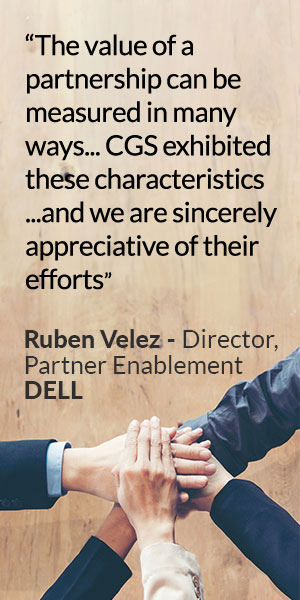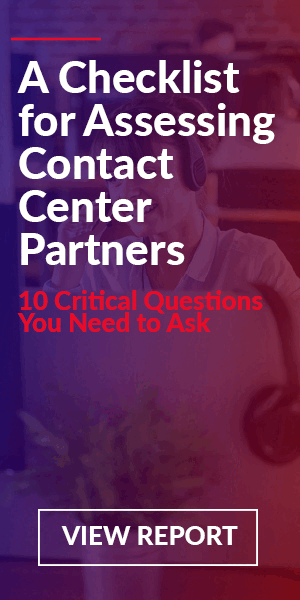The 3 Basic Rules of Call Center Excellence

“People, Processes, and Tools are the foundational building blocks for a successful BPO support model. However, even with the best technologies and tools in place, not having the proper recruiting, hiring and training processes will impact your ability to successfully deliver consistent quality support to your customers,” said Mike Mills, senior vice president, Global BPO Sales, Global Outsourcing division at CGS. “Once you invest in your people, which is your most critical asset in customer service solutions, the future success of your team and your customer is assured.”
Mills’ words reflect recent findings in our 2022 BPO and Customer Care Dynamics report, which revealed that flexibility/willingness to grow with a company’s needs, level of agent skills and investment in digital transformation were some of the top factors in evaluating new outsourcing partnerships.
Included in these top trends were artificial intelligence (AI), chatbots, automation and other technologies that can reduce the cost of outsourcing. And while technologies are having a profound impact on outsourcing, the basics of people, performance and management still come into play for a successful BPO program. Outsourcing clients are still looking for:
- Low agent turnover
- Increased agent tenure and knowledge of a client’s business
- Consistent training
- Performance measurement programs

Rule #1: Invest in Your Agents
This is the time to reflect on how to attract and retain top talent to your contact centers. Ask yourself: Do you have the most competitive pay rate, a proper reward system, a positive work culture and opportunities for career advancement? All these employment benefits to your potential agent must keep up with or exceed industry standards and be thoroughly explained during the recruiting process. By investing in these fundamentals, you will cast a wider net for potential applicants and improve how your internal brand is perceived by prospective hires.
There are many challenges when it comes to recruiting the right talent. According to The Conference Board, 69 percent of CEOs plan to expand their workforce, but 74 percent said they have problems attracting qualified people.. Your next step is to ensure each contact center candidate matches your required skill set in the screening process. Here are some considerations for hiring future agents:
- Experience: All applicants must have the core skills you require. This includes both technical and soft skills, as well as the capacity to learn on the job. You must be able to match the right agents allocated for the appropriate service level and project.
- Language: Test their language skills during the interview process. Don’t simply rely on certifications.
- Tenure: Check how often they’ve changed jobs in their career. Avoid hiring agents who switched jobs within less than one year, on a repeat basis.
- Attitude: Assess how they have approached difficult challenges in the past and how they were able to resolve them. Did they have a positive attitude? Soft skills are absolutely critical to sustained high customer satisfaction results.
Keep in mind that changing demographics require changing the recruiting strategy. According to CNBC, an estimated 61 million members of Generation Z are poised to enter the workforce. As a result, companies must make the contact center recruitment process a lot more fun and interactive. According to HR Executive, Gen Z wants to connect with the company, its culture and its purpose. Creating a consistent, memorable brand with stories really resonates with this demographic. They want to have a personal connection with the company.
Once an agent joins the team – what do you do to keep them engaged? The key is working with a top-notch HR and operations team that works cohesively to initiate the onboarding process. On the training side, if you don’t follow the right hiring and screening process, you may be constantly battling attrition that typically occurs during the training cycle.
“If you’re hiring people only to achieve a committed ramp-up plan or “managing to attrition” to backfill seats, you risk hiring agents with inadequate skill sets and false expectations with the role that they are being trained to perform. Transparency and open communication during the hiring process, coupled with the proactive trainee and trainer feedback during the first days of training is imperative. This tactic will reduce early attrition during the training phase,” said Mills.
He recommends the following checklist when it comes to training your agents:
- Trainers: It is imperative that you have a qualified and experienced trainer.
- Class size is critical: Aim to have one trainer for every 20 agents you teach.
- Nesting: Typically, specialists-in-training should practice “nesting” by taking live calls as part of their training with someone shadowing them. It may take 2-3 weeks before new agents can make these live calls on their own.
Customer service training pays big dividends for companies that stick with it. It is crucial for the prospective agents to have a lot of in-depth training, so once agents hit the floor, they are hitting the key performance indicators (KPI) from day one. The better the fit and the more informed agents are, the better your retention.

Rule #2: Create a Positive Work Environment
Despite advances in technology, the focus remains on customer satisfaction. How do you motivate employees to improve customer satisfaction scores? It all comes down to how well you do workforce management. First and foremost, you have to forecast your contact volumes precisely. Forecasting involves the calculation of future contact volumes, which can be done in Excel or using calculation tools by:
- Analyzing historical data to do a yearly forecast
- Looking out for seasonal trends
- Looking at day-by-day trends
You also need to recruit and hire experienced and seasoned managers who want to create a positive culture by promoting stability, transparency, continuity, consistency and quality. In fact, 75 percent of candidates will research a company’s reputation before applying for a job opening. Some 62 percent of job seekers use social media channels to evaluate the employer brand of a company. And a strong employer brand reduces turnover by 28 percent and cost per hire by 50 percent.
The management team can accomplish this by creating an honest and open workplace culture with clear goals and objectives for each employee within the contact center. Said Mills, “It is imperative that you align both the agent and floor leadership goals and objectives; empowering each employee with the ability to hold each other accountable for their own and the Team’s success.”
As previously mentioned, a pay-for-performance compensation system for your contact center is only beneficial if it aligns to the financial and business objectives of the company. The capability for agents to earn additional pay through their performance is essential to employee retention and increased productivity, resulting in additional revenue generation for your company. In recognizing top performers through a pay-for-performance program, you are creating the foundation for a positive workplace environment that enables healthy competition among the employees in the success of themselves, their teams and the company as a whole.
Managers can also provide flexibility in employee scheduling, mentorship programs and one-on-one meetings, as well as opportunities for volunteering. Providing agents with innovative tools, such as AI or chatbots, can relieve them of repetitive tasks better managed by a computer system.

Rule #3: Metrics Are Still a Priority
No matter how advanced your tools and processes, it all comes down to customer satisfaction. Your KPIs are critical from a process perspective. Whether you’re using customer tools in your own environment or a client’s toolset, if management promotes a proactive approach for driving optimization and efficiency, you will be successful. Here are some basic metrics that play a crucial role at your contact center:
- Average speed to answer (ASA): Workforce management, proper forecasting and mitigating absenteeism are critical to achieving this KPI.
- Average handle time (AHT): Proper training of the agents, floor leadership and quality management are all instrumental in reducing overall AHT through faster first call resolution, and/or establishing baseline AHT to ensure high levels of customer satisfaction.
- First call resolution (FCR): This KPI, as well as the two above, are all critical to achieving and maintaining consistently high levels of customer satisfaction. The “trap” that must be managed effectively is when you hold agents accountable more for FCR than AHT, especially when AHT caps are in place, agents will stay on the phone longer to resolve the issue, when in fact they should be escalating to Level 2 as required. Proper training and coaching are essential to attaining a successful balance between FCR and AHT.
Regardless of whether your customers interact with any combination of live agents, AI, chatbots or other technology to resolve an issue, innovative thinking, such as going beyond the script, will always play a positive role when resolving an issue. Answering calls quickly and minimizing the time to resolution are important, but agents should not prioritize them at the expense of customer satisfaction.
Managers should avoid a culture where agents are trying to get customers off the phone quickly without resolving an issue fully for the sake of KPIs. The most important factor in all interactions with your contact center support teams is the overall customer experience. Adherence only to KPIs can actually be a detriment to the “customer experience” if agents are compromising customer satisfaction for KPI attainment. To achieve success, management must create a balance of the three foundational elements of a successful contact center model: People, Process and Tools.
Strong leaders who promote this “out of the box” type of culture will continue to see customer ratings climb and agent attrition drop. To learn more about executives’ and decision makers’ plans around outsourcing and customer care, including evaluating partnerships and technology, download your copy of our annual report, 2022 BPO and Customer Care Dynamics: Serving the Customer in an Increasingly Complex World.


